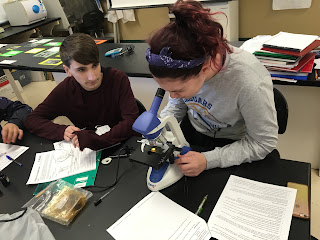Investigations, Communication, and Open House
Open House
Both morning and afternoon students have been busy transplanting roughly 350 lettuce plants in preparation for Open House. Once the lettuce is ready for harvest, we will cut it and share with Culinary Arts here at SCVTHS. A good rule that the Culinary Arts Instructor shared with us is that each one gallon sized zip top bag contains enough lettuce for ten small salads. We will record how much lettuce we harvest and share and hope to meet, or go beyond, prior years in harvesting. 

Investigations - FANR, Plant Science, Research & Development
Intro to Food, Agriculture, and Natural Resources students performed an investigation to determine how wind impacts plant cell hydration and the plant's ability to maintain upright structure. Students set up the experiment on a Friday, collected plant height data (measured height with a ruler) for the first 20 minutes, and then one last collection 72 hours later. Students then wrote a lab report and used the lab report info to produce what we call a mini-poster. The Mini-poster is a tool I am using to get students familiar with the process of presenting and communicating their findings with others. I hope to have all student posters displayed for Open House.
Plant Science students recently performed an experiment to test impacts environment has on a plants use of water to maintain itself. They used a more powerful tool to measure the water use: a gas pressure sensor. When water exits the leaf, it creates a vacuum pressure which students could measure with this sensor and data was recorded on a data logging device. After the experiment was complete, students used the data logger to process the data (math operation) and determine an equation for a linear regression and line slope. The line slope value was then used to compare the rate of water loss with a control.Communication
In the photo below, a student is creating a mini-poster using info created in the lab report.
Animal & Plant Biotech
Animal and Plant Biotech students are currently learning the processes for introducing novel DNA into a plant using genetic transformation. One the of the processes they are also working on sterile plant tissue culture. In the photo below students have cultured a fern. Biotech students are establishing sterile carrot cultures in class this week. The hope will be for students to turn a small carrot piece into a whole plant again.
Agriculture Research and Development
Students in the R&D class have chosen to explore methods of controlling oil spills in water using microbes to clean the water by converting the oil to less harmful hydrocarbons, such as methane. In the photo below, a student in is preparing to culture the oil eating microbes. After culturing students will then count the number of microbe colonies and determine which condition the microbes thrive and reproduce in. This is a pilot study that they will use to amplify the experiment.


















